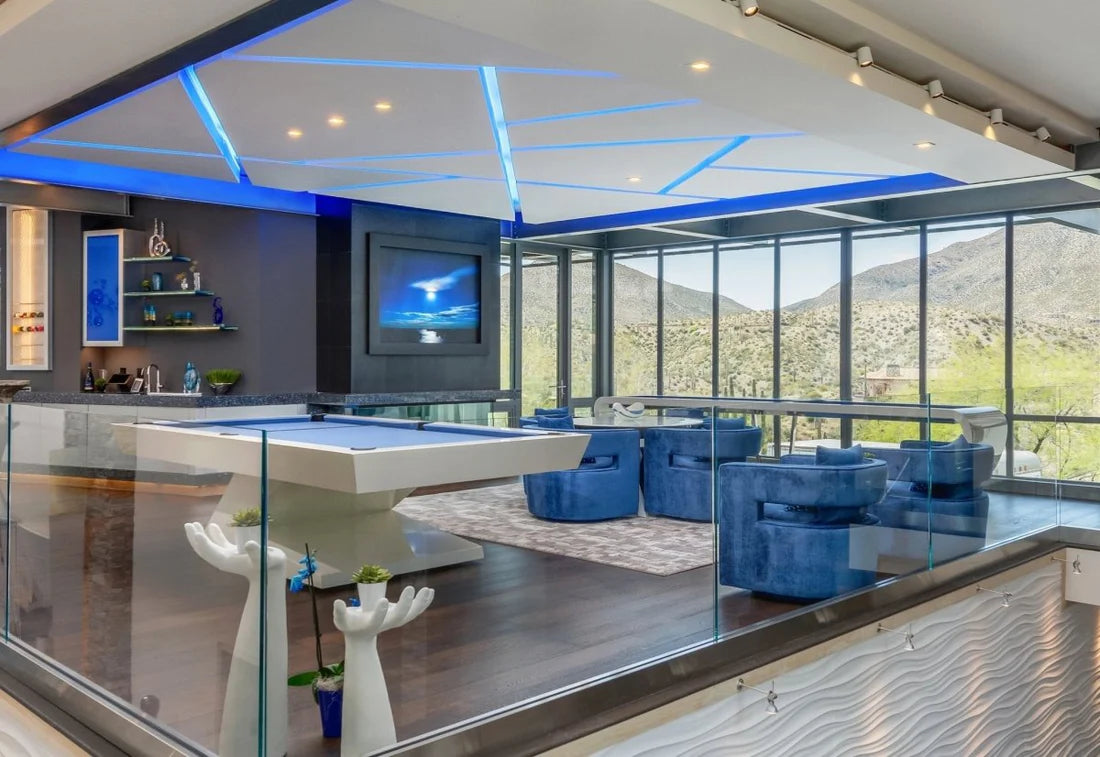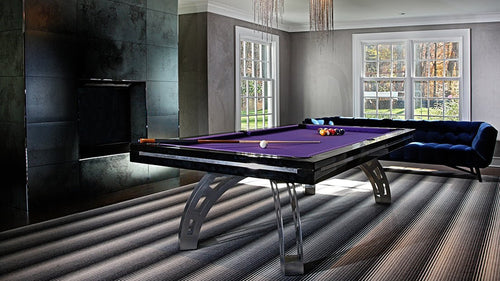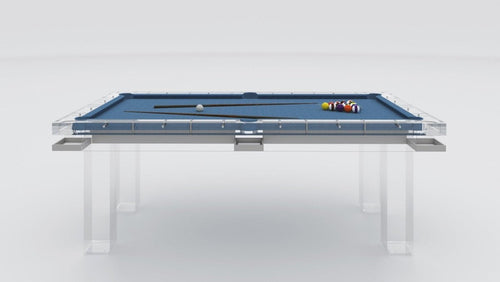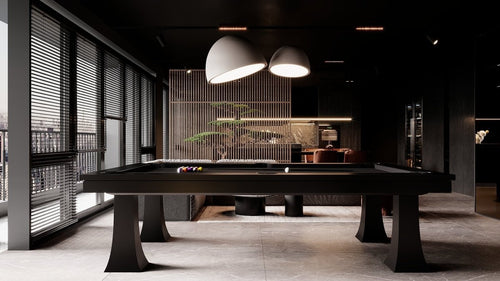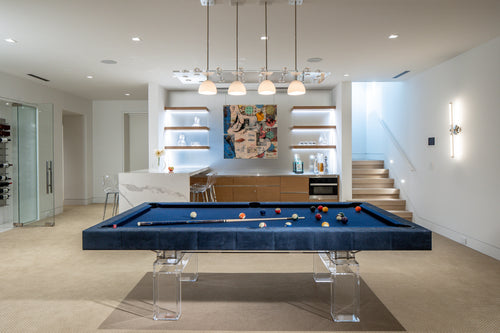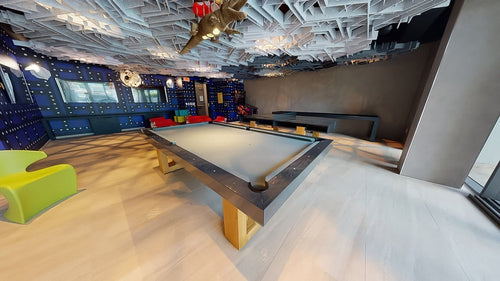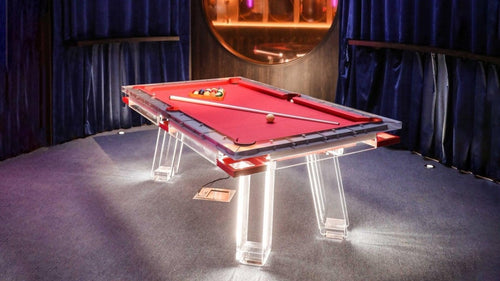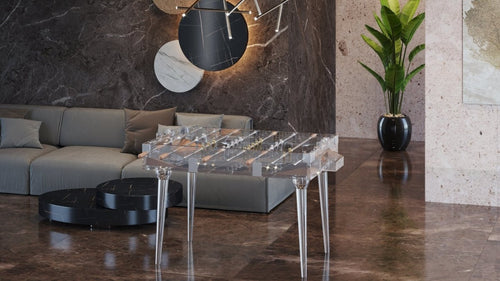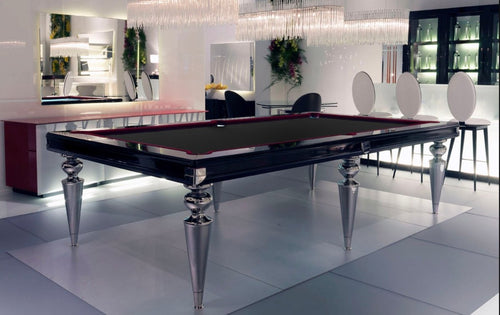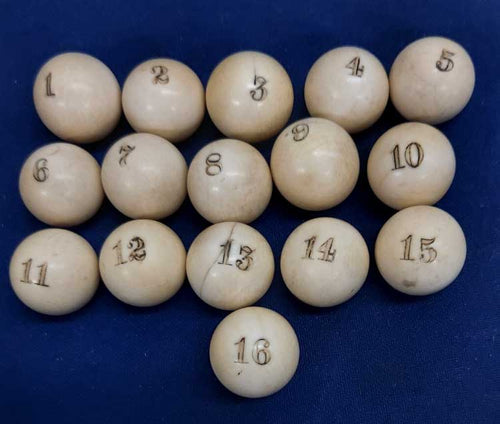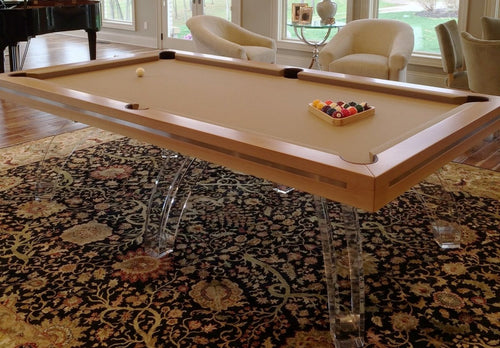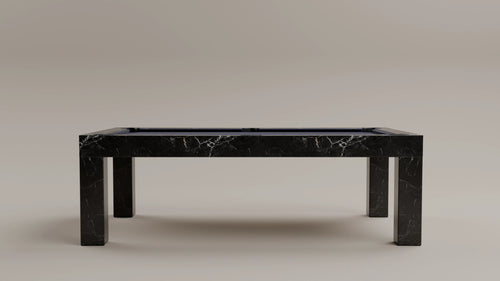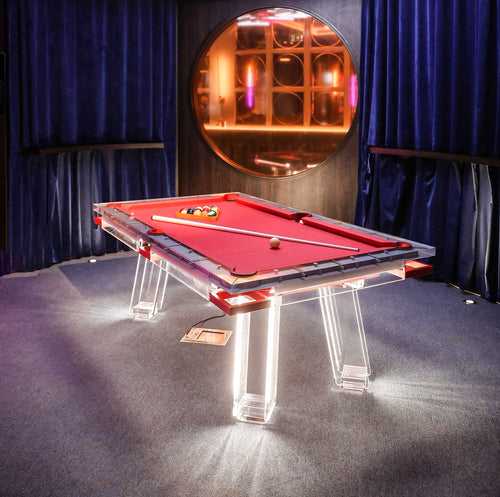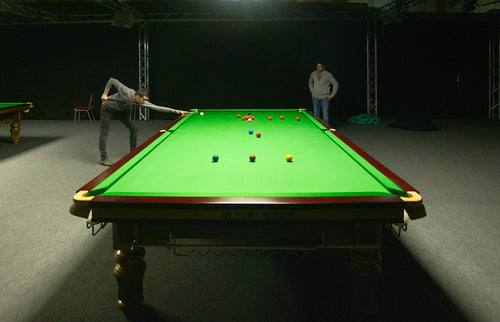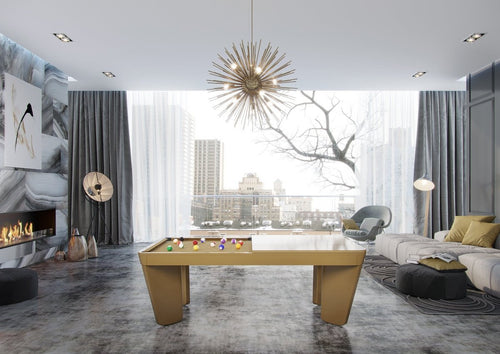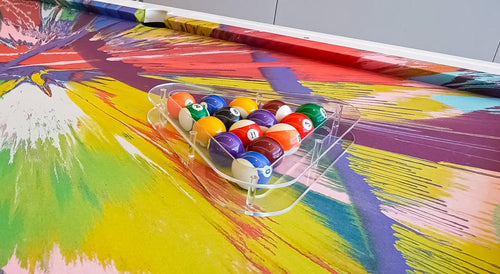Enjoy our modern designs
When adding a pool table to your living space, it's important to look beyond mere measurements and dimensions. While many guides focus solely on fitting a table into a room, they often overlook the art of integrating it in a way that enhances the room's ambiance and visual appeal. This comprehensive guide delves deeper than basic room size and functionality, exploring interior design principles that transform a pool table into a captivating centerpiece. From furniture layout and lighting to color schemes and décor, discover how to seamlessly balance style and functionality, creating a room that's as inviting as it is practical.
Understanding Pool Table Sizes

Before diving into design details, it's essential to understand pool table sizes and their space requirements. Pool tables come in several standard sizes, each requiring specific surrounding space for comfortable play. Here are the most common options:
-
7-Foot Table: Ideal for smaller rooms or recreational spaces.
- Recommended room size: 12’ x 16’
-
8-Foot Table: A popular choice for home and commercial settings.
- Recommended room size: 13’ x 17’
-
9-Foot Table: Standard for professional play, requiring a larger area.
- Recommended room size: 14’ x 19’
Note: These room sizes allow for cueing space on all sides of the table.
If you're interested in a more detailed breakdown of pool table sizes or need help choosing the right one for your space, check out our in-depth guide
Cueing Space: Ensuring Playability

Adequate space around the table is essential for uninterrupted gameplay. For optimal playability:
- Cue Length: Standard cues are about 57-58 inches long.
- Space Around the Table: Leave at least 5 feet (60 inches) from each side of the table to the nearest obstacle (walls, furniture, etc.) to accommodate cue length and backswing.
This buffer zone prevents players from bumping into obstacles and keeps the game's flow smooth. In tighter rooms, shorter cues (e.g., 52" or 48") can reduce minimum space needs by about a foot, though many players find these less enjoyable for regular play.
Tip: Before committing to a specific table size, simulate the available space and try using shorter cues at a local pool hall to see if the reduced cueing space works for you. Keep in mind that taller furniture, such as bookshelves, may interfere with cueing, while lower items like sofas may not, depending on their placement.
For extra planning assistance, PoolTable Portfolio offers free rendering services to help you visualize how the table will look and fit within your space, making it easier to see if your chosen setup is right for you.
Accessibility and Flow
- Unrestricted Movement: Ensure there is ample space around the pool table to facilitate smooth gameplay and maintain a natural room flow. Aim for at least 5 feet of clearance on all sides to allow players to maneuver comfortably.
- Avoid Obstacles: Steer clear of tight corners or narrow walkways that can hinder movement and detract from the enjoyment of the game.
- Doorway Widths: Verify that doorways are wide enough for easy movement of people and furniture. Being accessibility-minded, a clear opening of at least 32 inches is essential for standard wheelchair accessibility.
Flooring

- Stability and Durability: Opt for flooring that can support the pool table's weight and withstand heavy use. Hardwood, laminate, or high-quality carpet are excellent choices that combine functionality with aesthetic appeal.
- Carpet Considerations: If using carpet, place a hard surface under the table legs to prevent indentations and maintain stability.
- Aesthetic Impact: Choose floor colors and textures that enhance the room's atmosphere. Lighter colors can create a bright, spacious feel, while darker tones add depth and warmth.
Acoustic Considerations
- Sound Absorption: Pool games can be lively and noisy. Incorporate sound-absorbing elements like soft furnishings, rugs, or acoustic panels to minimize noise and improve comfort for players and spectators.
- Material Choices: Soft surfaces help muffle sounds, reducing echoes, while hard surfaces reflect sound and can make the room feel more vibrant.
- Location Matters: Position the pool room away from noise-sensitive areas like bedrooms. If necessary, add insulation to walls, ceilings, or floors for better sound control.
Creating a Visual Focal Point

- Table Design: Choose a pool table that complements the room's décor. A sleek, modern table suits a contemporary setting, while a classic wood-finished table enriches a traditional space.
- Placement: Position the table centrally or against a feature wall to make it the natural centerpiece without overwhelming the room.
- Enhancement: Use lighting to highlight the pool table, making it a stunning focal point that draws attention and defines the space.
Enhancing the Room’s Mood and Atmosphere

Lighting
- Ambient Lighting: Utilize ambient lighting to create a relaxing environment, especially when the pool table is being used for activities other than gameplay. Wall sconces, recessed lighting, or ceiling fixtures can provide general illumination that adds warmth and ambiance to the space.
- Accent Lighting: Incorporate accent lighting to highlight specific features in the room, such as the pool table or artwork. This type of lighting adds visual interest and depth. For example, a track lighting system allows you to direct light beams precisely where you want them, making it easy to spotlight the pool table during games and other focal points at different times.
- Even Illumination: Ensure the playing surface is evenly illuminated without casting shadows for optimal gameplay. Overhead fixtures like chandeliers, pendant lights, or specialized pool table lighting can provide the necessary brightness while also serving as decorative elements. Chandeliers may offer more sparkle than illumination but contribute to a refined aesthetic.
- Light Color and Temperature: Consider the color of light emitted by different sources and how it interacts with the room's color scheme. Warm light can accentuate warm colors and create a cozy atmosphere, while cooler light enhances cool tones and promotes a sense of calm sophistication.
- Adjustability: Use adjustable lighting fixtures and dimmers to switch seamlessly between game-focused lighting and softer mood lighting for other activities. This flexibility allows you to create the perfect ambiance, whether you're playing pool or hosting a social gathering.
Decorative Elements
- Personalization and Refinement: Infuse the space with personality by adding artwork, plants, or decorative accessories. Carefully curated pieces can emphasize strong design elements, alter the perception of the room's proportions, and reinforce your intended design concept, transforming the area into a refined living space rather than just a game room.
- Style Choices: To achieve a modern industrial look, consider incorporating elements like exposed brick or decorative trusses. Exposed brick walls, whether authentic or simulated, add texture and character. Decorative trusses, even if they don't offer structural support, enhance authenticity and visual interest.
- Wall Décor and Storage: Enhance the room's functionality and aesthetic appeal by adding wall-mounted décor and storage solutions. Use wall-mounted cue racks, shelves, or artwork to integrate practical needs with the overall design, keeping the space organized and stylish.
- Plants: Incorporate plants to add life and vibrancy. Both real and artificial greenery can improve the room's atmosphere and contribute to a healthier indoor environment.
Adjustability and Flexibility
- Lighting Flexibility: Install adjustable lighting fixtures to accommodate different activities. Dimmers allow you to control the brightness, adjusting the ambiance according to the desired mood. Task lighting with adjustable brightness and direction can illuminate specific areas for work or other purposes.
- Furniture Arrangement: Adjust furniture placement to create different zones within the space. Arrange seating to accommodate both pool games and other activities, using furniture to define distinct areas for various functions. This adaptability maximizes the room's utility and caters to different needs throughout the day.
- Color Palette and Textures: Choose a color palette that complements your design aesthetic and evokes the desired mood. Warm, earthy tones create a cozy, inviting atmosphere, while cooler tones promote calm and sophistication. Layering textures through furniture, rugs, and accessories adds depth and interest to the space.
- Additional Considerations: Install a sound system to play music or create specific soundscapes for different occasions, enhancing the overall atmosphere. Use window treatments to control natural light and privacy, allowing you to adjust lighting levels throughout the day. Ensure the room has adequate temperature control to maintain comfort regardless of the activity.
Multifunctional Spaces: Beyond the Game
In modern interiors, pool tables can serve multiple functions, such as doubling as a dining table or workspace. Pool dining tables offer a practical solution for spaces where a dedicated game room isn't feasible. These tables feature removable or adjustable tops, allowing them to seamlessly transition between a pool table and a dining table. For those who work from home, a pool table that converts into a workspace can provide a unique and functional alternative to a traditional desk.
Adaptable Designs

Choosing tables with removable or adjustable tops allows you to easily transform the space according to your needs. This adaptability enables you to maximize the functionality of your space and cater to different activities throughout the day or week. At PoolTable Portfolio, we offer tables with interchangeable tops that provide even greater versatility—for example, a dining top for meals, a work surface for office tasks, or even a ping pong top. Additionally, consider a table with a built-in storage system, which can be useful for storing pool cues, balls, and other accessories when the table is being used for dining or work.
Personalization and Style

- Custom Touches: Personalize the pool table to seamlessly blend with the room's overall style—be it contemporary, traditional, or eclectic.
- Unique Features: Add bespoke cushions, distinctive cue racks, or custom finishes to make the table a true reflection of your taste.
- Statement Piece: By customizing, the pool table becomes more than just furniture; it turns into a statement piece that enhances the room's character.
Conclusion
Incorporating a pool table into your living space provides the perfect blend of functionality and elegant design. By addressing practical aspects like accessibility, flooring, and acoustics, while also focusing on aesthetics and personal style, you can create a space that is both enjoyable and visually captivating. Thoughtfully positioning the pool table as a focal point, coordinating colors and textures, and enhancing the atmosphere with well-planned lighting and décor will transform the room into a versatile and stylish haven. Whether for casual play or sophisticated entertaining, a well-designed pool room becomes the heart of your home, offering recreation and a true reflection of your unique style. Explore custom luxury tables. If you have questions or need assistance, contact us at sales@pooltableportfolio.com.


